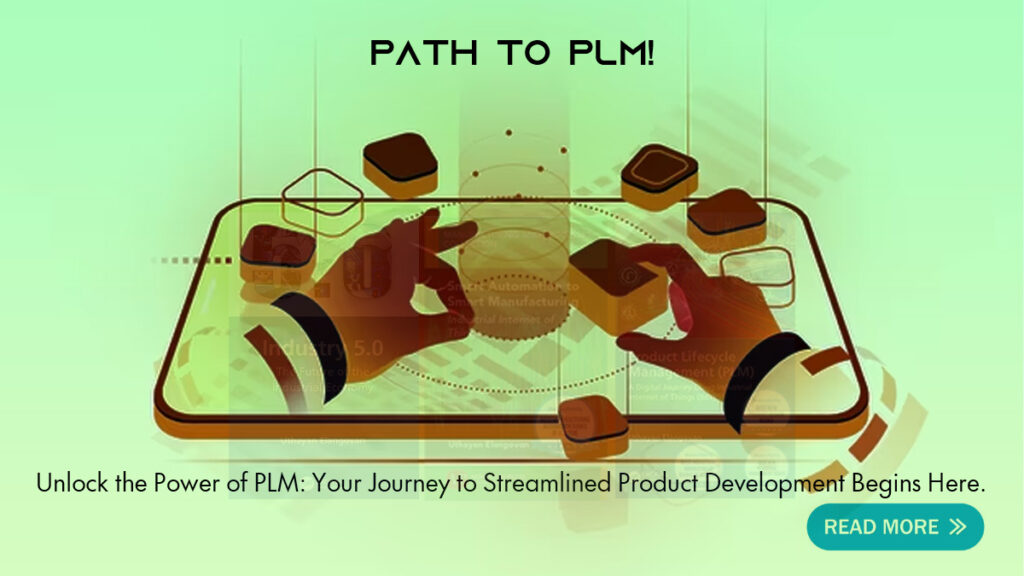The Path to PLM Success: Unleashing Efficiency and Collaboration in Product Development.
Introduction:
In the ever-evolving business environment of today, organizations are driven to optimize efficiency, streamline operations, and maintain a competitive edge. Product Lifecycle Management (PLM) has emerged as a powerful tool to help businesses achieve these objectives. By implementing PLM, organizations can enhance collaboration, optimize product development, and accelerate time-to-market. However, embarking on a PLM journey can be overwhelming. Here, we will discuss the first steps to take towards PLM implementation in your organization, supported by real-world examples, to guide you towards a successful transformation.

Step 1: Define Your Objectives
Before diving into PLM implementation, it’s crucial to establish clear objectives. Determine what you aim to achieve with PLM, such as improving collaboration, reducing time-to-market, or increasing product quality. By defining these objectives, you set a clear direction and ensure that the implementation aligns with your organization’s overall strategy. For instance, a manufacturing company may set an objective to reduce product development cycles by 30%, enabling them to respond swiftly to market demands and gain a competitive edge.
Step 2: Assess Your Current Processes
To identify the areas where PLM can bring the most significant impact, it is essential to conduct a comprehensive assessment of your current processes. Analyze how product data flows across different departments, identify bottlenecks, and pinpoint pain points. For example, a consumer electronics company may discover that their manual document management system results in version control issues and delays in product releases. By understanding these challenges, you can prioritize PLM functionalities and tailor the implementation to address specific needs.
Step 3: Select the Right PLM Solution
Choosing the right PLM solution is critical for successful implementation. Research various PLM providers and evaluate their offerings based on your requirements and budget. Take into account essential factors like scalability, user-friendliness, integration capabilities, and available support services. Seek out case studies and testimonials from organizations similar to yours to gain insights into the benefits they derived from a particular PLM solution. For instance, an automotive manufacturer might select a PLM platform known for its robust change management features to streamline their complex engineering change processes.
Step 4: Create a Cross-Functional Implementation Team
PLM implementation should not be limited to the IT department. Establishing a cross-functional team consisting of representatives from different departments is essential to ensure a successful rollout. Include individuals from engineering, manufacturing, procurement, and quality assurance, among others, to gather diverse perspectives and ensure alignment with business goals. For example, a medical device company might involve stakeholders from regulatory affairs to ensure compliance with industry regulations throughout the implementation process.
Step 5: Develop a Phased Implementation Approach
Rather than attempting a large-scale implementation all at once, it is advisable to adopt a phased approach. Break down the implementation into manageable stages, allowing for testing, feedback, and gradual adoption. For instance, a fashion retailer may initially focus on integrating PLM into their design and product development processes, gradually expanding its usage to other areas. This incremental approach mitigates risks, facilitates user acceptance, and delivers tangible benefits early on.
Conclusion:
Implementing PLM is a transformative journey that requires careful planning and execution. By following these initial steps – defining objectives, assessing current processes, selecting the right PLM solution, creating a cross-functional team, and adopting a phased implementation approach – your organization can lay a strong foundation for success. Remember that successful PLM implementation goes beyond technology; it involves fostering a culture of collaboration, continuous improvement, and embracing change.
SMEs learn about OpenBOM PLM. Discrete Manufacturers learn about PTC Windchill.
Are you ready to unlock the potential of PLM in your organization? Begin your journey towards a smoother and more effective product development process. Start by setting clear goals for your Product Lifecycle Management (PLM) implementation, evaluating your current practices, and exploring suitable PLM solutions. Involve important team members and create a diverse implementation team. Take a step-by-step approach to implementation and enjoy the advantages of enhanced teamwork, quicker product releases, and improved product quality. Connect with Neel SMARTEC Consulting to kickstart your PLM journey and outshine your competitors.


